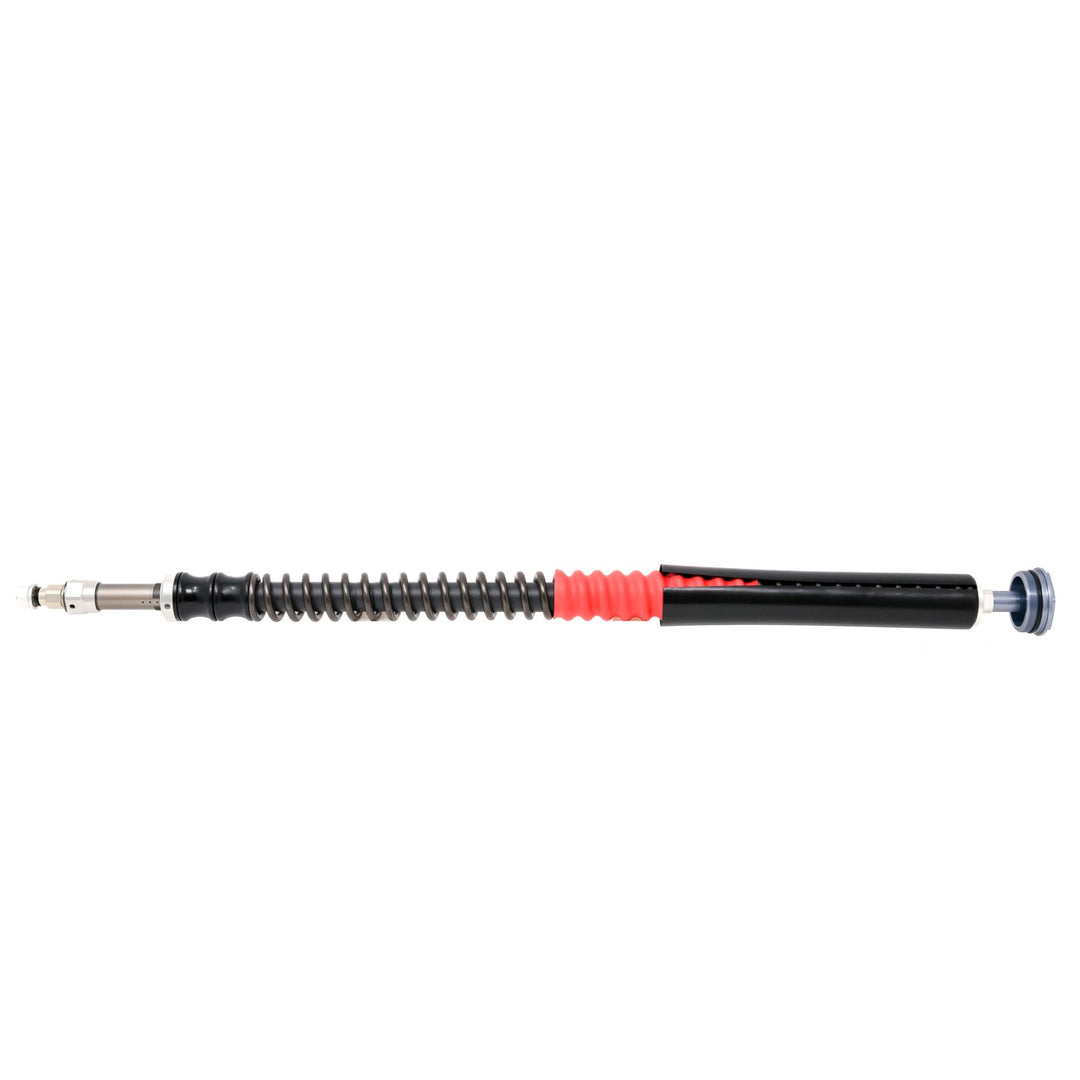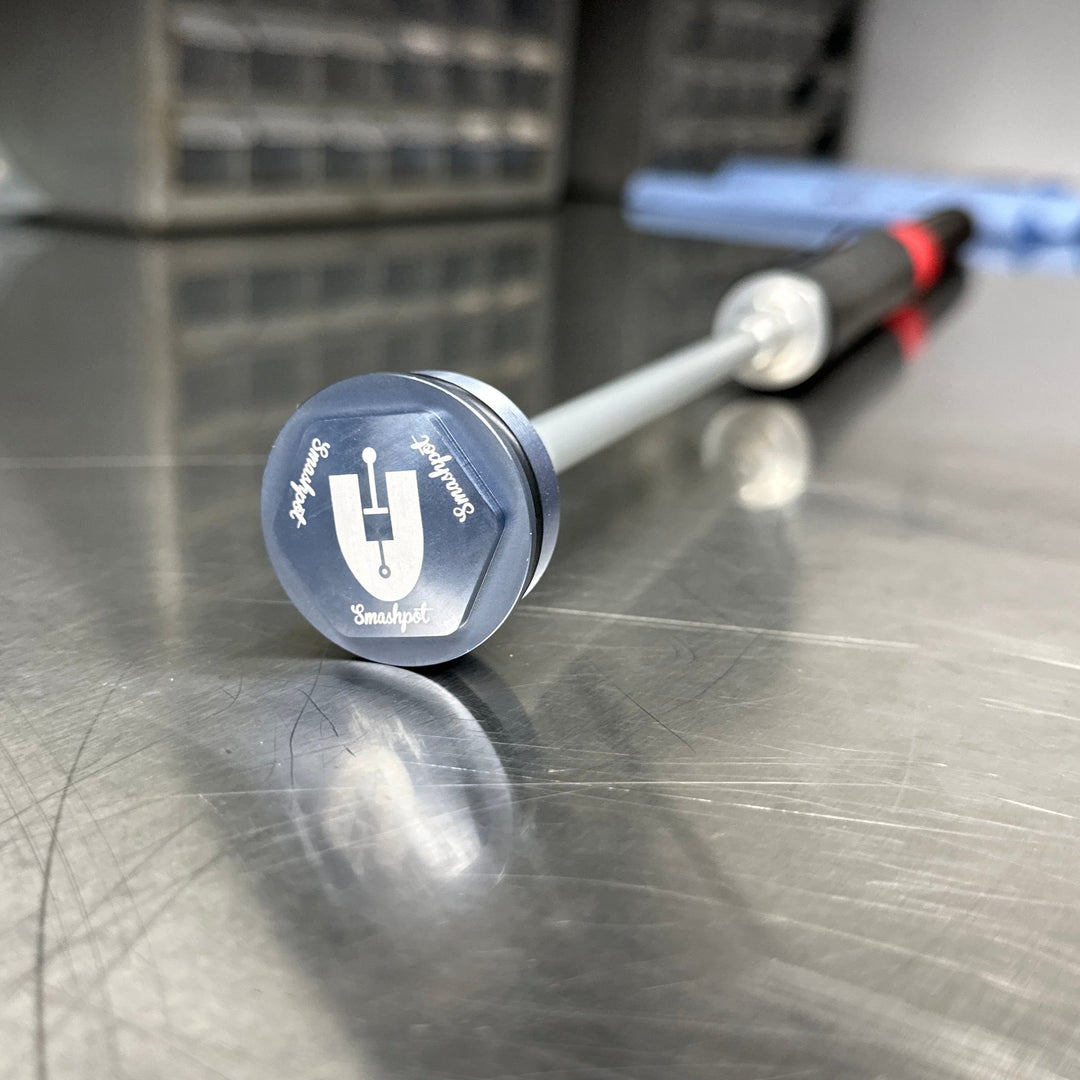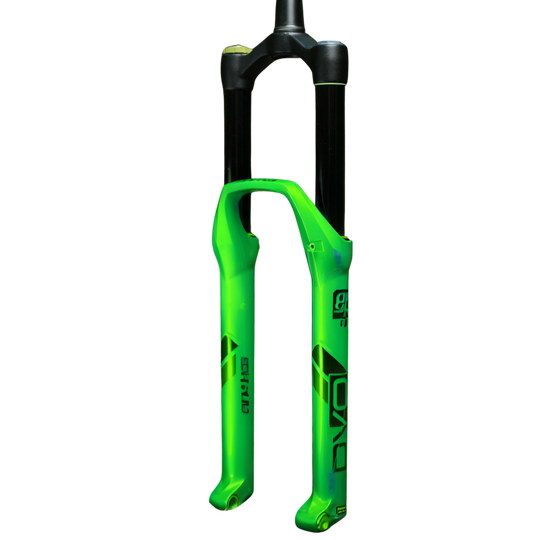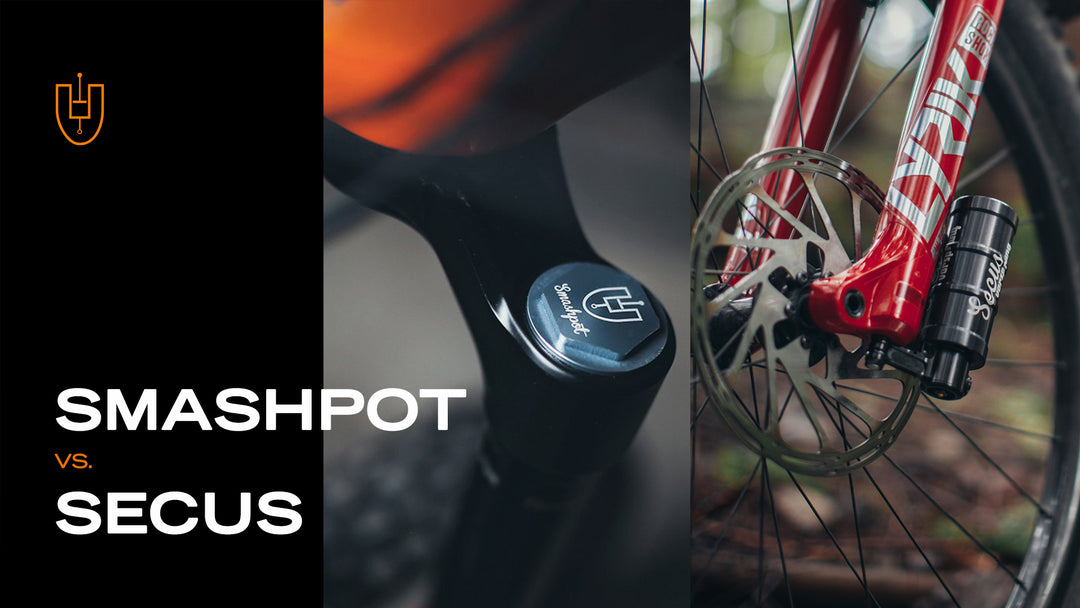Run over EVERYTHING.
Experience phenomenal grip, control and sensitivity that you didn't know mountain bikes could even have, with the Smashpot V2- the bottomless fork coil spring conversion system for long travel MTB forks.
What's My Spring Rate
It is important to consider where/what you ride the majority of the time for the best recommendation. Each input is explained below.
Rider Weight: This is your weight fully kitted (including gear & pack). An approximation is fine. Use the toggle to switch between units.
Bike Weight: If you know roughly, great! If not, 33lbs/15kg for a regular bike, 50lbs/23kg for an e-bike. Use the toggle to switch between units.
Terrain Speed: This is a measure of the speeds naturally inherent to the terrain you ride. A moderate downslope with open corners will favour high speeds. Low angle, undulating terrain with a lot of pedalling, or persistent steeps, promotes low speeds.
Rider Level & Aggression: Your ability to attack any given trail, including corners, rough and slippery terrain, and steep sections at speed.
Strength to Weight Factor: We're not all Olympic athletes. Will an unexpected hard compression throw you off the bike? Can you handle a sustained beating down a 5 minute trail without taking a break?
Jump Size: Consider the size of the jumps you like to ride. Some comparisons:
Small - jumps up to a bike length long, drops up to 2ft.
Medium - Most table tops, small gaps, and less-than-head height drops. Think Crank It Up to A-Line.
Rampage - Big gaps, huge step downs, stuff that looks like it should be done on a moto. Red Bull Rampage, FEST Series events, Crabapple Hits, Dreamline, etc.
Preferred Feel: A compliant setup will give better bump sensitivity and be easier on the rider. A stiff setup will favour support but will be a bit more physically demanding on the rider.
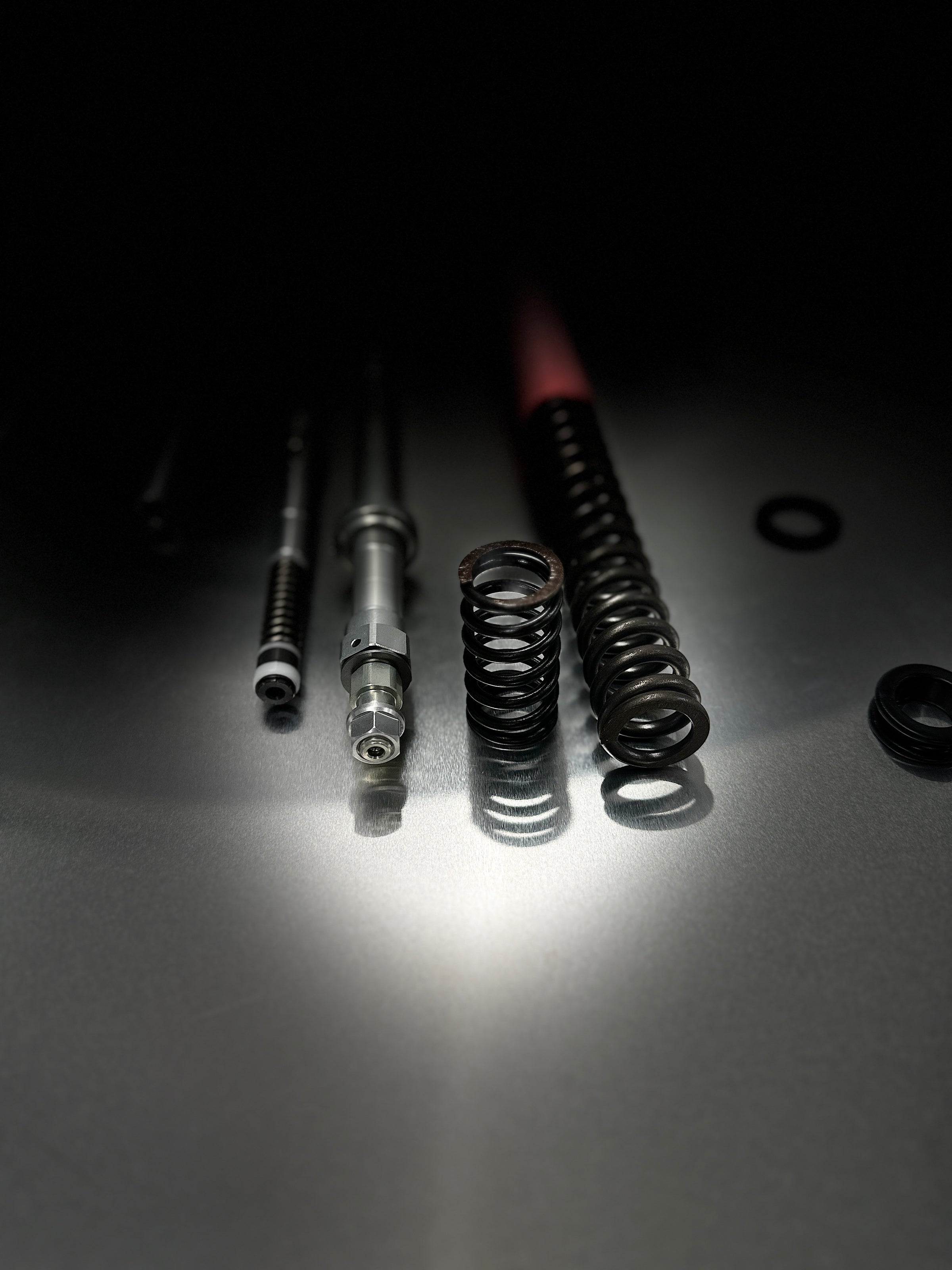
What's new for Smashpot V2 vs V1?
140-200mm travel (fork max travel permitting) vs 130-180mm
Low-profile external hydraulic bottom out (HBO) adjustment
Larger topout spring for silent engagement on big pulls
Dual crown compatible - bringing coil back to downhill
Dual-rate progressive springs for 180-200mm travels
Wider range of external HBO adjustment
Devour the roughest trails like never before.

Dual-Rate Progressive Springs
New dual-rate progressive spring curves for 180-200mm travel settings give you the ultimate combination of initial compliance and deep stroke support.
Say goodbye to harshness. You've never ridden a mountain bike fork that felt this good.

Supple? Yes. Supportive? Yes.
Eat up the small stuff without compromising on the big compressions.
Smashpot V2 is more progressive at firmer spring rates - more support for heavier & harder-charging riders, without restricting travel usage for lighter & more cruisy riders.
How do I specify the travel I want?
Travel is set internally during installation, anywhere from 140mm to 200mm (don't exceed the maximum your fork is able to use!). You don't need to specify a travel when you order - your kit can do any of those.
How much weight does it add?
It's heavier than your air spring by between 250-450g, depending on spring rate (firmer springs are generally heavier) and the fork's original spring system. If the weight bothers you, you may be more interested in a Luftkappe or Secus.
Can I convert my fork back to air afterwards?
It depends, on some forks like Ohlins or the F38 that doesn't use the ID of the stanchion as sealing surface, then yes, possibly. There is a risk that spring rub may score the inside of your stanchion, so the the air piston may not seal again. The spring is both isolated and guided to minimise stanchion knock and rub, however we cannot guarantee an air spring will seal again after riding with a spring installed. We'd be pretty surprised if anyone actually wanted to do this after riding the Smashpot though.
Does it void the fork's warranty?
As with any aftermarket modifications, it should be expected to void the fork manufacturer's warranty.
Do I need any extra parts to change the travel?
All spacers required are included with the kit. If you do not have the original parts, you may also need 'Travel Adjust Kit'. You will want more heat shrink for the cartridge tube, as it's installed after travel is set internally. CLICK HERE FOR SPARE PARTS.
More info can be found here.
Typical fork maximum permissible travels:
These change year by year across year models (for example, Lyriks from 2016-2022 were 180mm max, but from 2023+ they are 160mm max). Check with your fork's manufacturer regarding the maximum travel of your fork - if in doubt, don't exceed what your existing fork is currently set to.
I'm changing travel and I want to source heat shrink myself. What size do I need?
Spring:
2:1 singlewall polyolefin non-adhesive, with an initial (non-shrunk) diameter of 1.25" (32mm).
1.5" (38mm) initial diameter will also work.
Outer tube:
2:1 singlewall polyolefin non-adhesive, with an intital (non-shrunk) diameter of 3/4" (19.1mm)
I'm moving the Smashpot over to an entirely new fork - what parts do I need?
See this: Parts required to change my Smashpot to a new fork
WARNING: VORSPRUNG products should be installed and serviced by a trained bicycle service technician, in accordance with both VORSPRUNG and original manufacturers' specifications. If you have any doubt whether or not you can properly service your suspension product, or you have not performed this kind of work before, then please DO NOT attempt it. Improperly serviced products can fail, causing the rider to lose control resulting in SERIOUS INJURY OR DEATH. That's not a joke. Don't mess around with it if you don't know what you're doing, because the best case scenario is usually that you damage something in the process. Do not perform any kind of service on your suspension whilst drunk, high or stupid. We accept no responsibility nor liability for component damage or failure of any description in the case of self-installed units.
Note that this is ONLY relevant for 180-200mm settings.
140-170mm only use one spring, and have a linear spring rate.
The Primary spring is the one you'll need to actually order. It's what determines the stiffer part of the dual rate progressive spring rate.
The lower value (eg the 38 in 38-55) is the starting spring rate, and the average is the average of the two at 200mm travel.
30lbs/in Primary: 24-30 lbs/in (26lbs/in average)
35lbs/in Primary: 27-35 lbs/in (31lbs/in average)
40lbs/in Primary: 30-40 lbs/in (35lbs/in average)
45lbs/in Primary: 33-45 lbs/in (39lbs/in average)
50lbs/in Primary: 35-50 lbs/in (44lbs/in average)
55lbs/in Primary: 38-55 lbs/in (48lbs/in average)
60lbs/in Primary: 40-60 lbs/in (53lbs/in average)
65lbs/in Primary: 42-65 lbs/in (57lbs/in average)
70lbs/in Primary: 45-70 lbs/in (61lbs/in average)
Key Features
Smashpot Features
- Turn your mountain bike into a monster truck
- Phenomenal sensitivity & bump-eating performance
- Consistent, predictable spring rate in all conditions
- Cuts fork friction roughly in half compared to an air fork
- Adjustable hydraulic bottom out control for the big hits
- Caters to rider weights from 45kg (100lbs) to 125kg (275lbs) with 11 coil spring rates
- Allows lighter riders to get the most use out of their forks
- Allows heavier riders the support they need without the harshness that comes with excessive air pressures
- Easily adjust your travel with internal spacers - no new parts required
- Unique Hydraulic Bottom-out System prevents harsh bottoming
- Can be transferred between different forks with minimal parts /cost
- Reliable and low maintenance, set and forget.
- Easy to install and easily serviceable




Why Coil?
Air springs have improved substantially over the years - and we've been at the forefront of air spring development for years, so we've got no bridges to sell you. Yeah, coils are heavier than air, and for some riders that alone is a dealbreaker - fair enough. The advantages of coil springs, however, are clear:
Zero stiction or friction in a coil spring. And no moving seals in the spring system to wear out, cause friction or leak.
Zero spring rate variation allowing more mid-stroke support and consistency.
More oil in the fork - lubrication and service life are improved.
In short, improvements in sensitivity, grip, compliance, mid-stroke support and consistency, with reductions in harshness and hand pain.
Adjustable Hydraulic Bottom Out Control
Weight aside, air springs outperform coil springs in one critical area: bottoming resistance. The hydraulic bottoming control valve addresses this with a speed sensitive shimmed valve which engages progressively and seamlessly in the last 40mm of travel, bringing the fork to a smooth and controlled stop at the end of the travel. High energy and low energy inputs are effectively managed without harshness. Easy tool-free external adjustment ensures you get as much or as little bottoming resistance as you need at the turn of a dial. Increased stability as energy is dissipated, rather than stored and thrown back at you.

Reviews
★★★★★Right now my bike is coil sprung front and rear and it's incredible. It’s heavy, for sure, but I prefer the gob-loads of traction, composure, and lack of faffing. And while the front weighs more than before, it actually strikes a more level balance...
Full review:
https://nsmb.com/articles/vorsprung-smashpot-coil-conversion-fox-36-reviewed/
AJ Barlas
NSMB
★★★★★I am a huge fan of coil sprung forks due to their incredible ability to smooth out the chunk on the trail and the phenomenal front wheel traction they provide, and the Smashpot is no different.
Read the full article here:
Jared Erickson
Worldwide Cyclery

Learn
Smashpot or Secus? Let's compare...
Most mountain bike forks these days are air sprung, likely due to being easily adjustable and light, however the performance benefits of coil springsare clear, so why one and not the other- ‘Should I go for the Smashpot or the Secus?’
Heavier Riders & Fork Performance
While there are no exact definitions or thresholds to identify a ‘heavier rider’, riders weighing more than 90kg (200 pounds) are likely to suffer from underdamped compression, initial harshness, insufficient support through the mid/late travel, and/or excessive, sudden end-stroke ramp with standard air spring designs.
The Limitations of Air Springs
Most forks that come on mountain bikes these days are air sprung, likely due to being lighter and more adjustable when compared to a coil sprung fork. Air spring designs have improved over the years, however there are still compromises on their performance which we will cover below.




